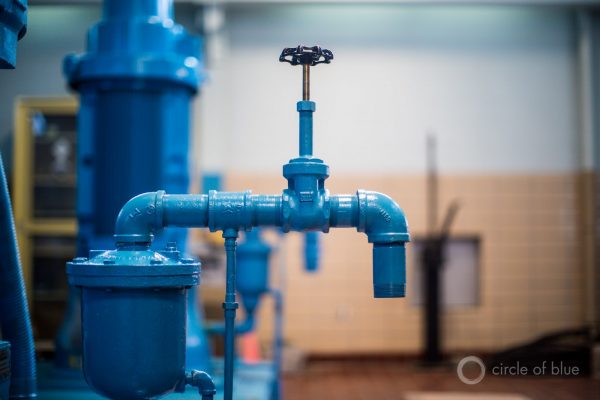Price of Water 2016: Up 5 Percent in 30 Major U.S. Cities; 48 Percent Increase Since 2010
Utilities respond to changes in water use and availability.
Utilities respond to changes in water use and availability.
By Brett Walton, Circle of Blue
America’s water systems were built to last. Philadelphia is one of the older cities on the Atlantic Coast and Northeast that still use pipes that were installed before the Civil War. The pipes have held up remarkably well over 160 years. But without new parts and maintenance these systems will not last forever. The repair bill has come due and water prices are increasing to pay for it.
The price of water rose 5 percent last year, according to Circle of Blue’s annual survey of 30 major U.S. cities. The median increase was 3.5 percent. The increase continues a steady upward climb in water prices that reflects investment in new infrastructure and a response to declining water sales. The average price climbed 48 percent since 2010.
 These adjustments are taking place at a time of deep uncertainty for utilities. The future of water bears little resemblance to the past. Demand is changing as households and businesses nurture a conservation ethic. They are installing appliances and fixtures that use considerably less water than their forebears. They are purifying and recycling their wastewater. Supply, too, is in flux. The planet is warming, throwing askew familiar weather patterns. The cheapest water sources have already been tapped.
These adjustments are taking place at a time of deep uncertainty for utilities. The future of water bears little resemblance to the past. Demand is changing as households and businesses nurture a conservation ethic. They are installing appliances and fixtures that use considerably less water than their forebears. They are purifying and recycling their wastewater. Supply, too, is in flux. The planet is warming, throwing askew familiar weather patterns. The cheapest water sources have already been tapped.
This era of change, a force of nature that all utilities must reckon with, is toppling old assumptions about how water systems ought to be operated. Foremost, according to Jeff Hughes, director of the Environmental Finance Center at the University of North Carolina at Chapel Hill is the need to recognize that water demand, like demand for energy, is not rising at the pace that was once projected. It may even fall.
“A lot of utilities became aware five to ten years ago,” Hughes told Circle of Blue. “It’s hitting others now for the first time. Some were surprised. A lot of utilities are implementing strategies to adapt. The basic strategy is that they are becoming much more conservative about projecting water use. They are finally getting it. People are using less water.”
Three main forces push against water utility managers. One is revenue. Utilities must earn enough money to maintain water treatment and distribution systems that, for large systems, include thousands of miles of pipe and billions of dollars in assessed value, while also investing in new facilities such as water recycling plants.
A second factor is conservation. Utilities are seeing sustained declines in the amount of water residents use. Indoor water use in the United States dropped 22 percent since 1999, largely because of efficient clothes washer and toilets, according to a recent study. Seattle uses about 30 percent less water in the winter, spring, and fall than it did in the 1980s.
The third consideration is equity. Utilities must ensure that rates are fair: affordable for the poorest and punitive for the water-wasters.
Balancing the three forces is always a difficult task. More conservation can dent revenue, for instance, and the need for more revenue can upend affordability. These conflicting trends exerted greater pressure on utilities last year than ever before.
The lead contamination scandal in Flint, Michigan, drew national attention to outdated pipes and the costs – political, economic, and social – of allowing known problems to go unaddressed. In California, state-mandated drought restrictions and other conservation measures resulted in a loss of an estimated $US 500 million in utility revenue in 2015. And lastly, the rising cost of water has united social justice groups into a national movement for affordable water.
The result of this turmoil is that utilities, rarely described as innovative or daring, are becoming more frequent experimenters. Not only are they raising water rates to respond to the challenges. They are also changing how those rates are designed. Changing, in other words, the recipe for revenue.
Of the 30 cities in the Circle of Blue survey, there was a burst of rate restructuring. Fort Worth, which uses increasing block rates, shrunk the size of the blocks. Under this type of rate, the first gallons of water are comparatively cheap, but the unit cost rises as more gallons are consumed. For Fort Worth, the first 600 cubic feet (4,488 gallons) are priced at $US 2.07 per 100 cubic feet (748 gallons), while the price for the next 1,200 cubic feet is $US 2.96 per 100 cubic feet. The first block used to cover 800 cubic feet.
Fort Worth, like many utilities that use an increasing block rate structure, has a problem. Because households are conserving, fewer are breaching the higher blocks, said Mary Gugliuzza, the Fort Worth water department spokeswoman. That means the utility is not selling as much expensive water. By recalibrating the blocks, revenue can be rebalanced.
“The change was to capture some of the lost revenue and to more adequately reflect the change in our customer’s usage patterns,” Gugliuzza told Circle of Blue.
The San Antonio Water Systems (SAWS) also revamped its rate structure because of revenue concerns. The utility discarded its seasonal rate structure, which charged residents more per gallon during the summer months, when demand peaks.
Mary Bailey, SAWS vice president of financial planning, offered two explanations for the change. First, “water is valuable year round,” she told Circle of Blue. “We want people to be conscious of it all the time.”
Second, the utility found itself with a $US 27 million budget shortfall last year because rain fell during the summer, and residents did not need to water their lawns. Outdoor watering can account for half or more of household water use. In the restructuring, San Antonio cut its rate for very low volumes of water, giving conservers a discount, and spread the rest of its revenue more evenly across the year.
Other utilities are operating at the cutting edge. Denver Water introduced a rate that varies the cost of water for each household depending on its water consumption pattern. Winter usage determines the size of the blocks for its increasing block rate. Philadelphia, at the request of the City Council, which was acting on concerns about affordability, is developing a water rate based on income.
“We’re not aware of any city that has the type of program we’re looking at,” Joanne Dahme, Philadelphia Water spokeswoman, told Circle of Blue. Dahme said that implementing the program, if it is approved by a hearing board, would take up to two years.
In his May 4 speech at Northwestern High School, in Flint, Michigan, President Barack Obama lamented the “corrosive attitude in our politics” that has resulted in the withdrawal of Republican support for infrastructure investment. The country’s political culture was not always that way.
In the 1970s, after the passage of the Clean Water Act, Congress offered a helping hand in mopping up dank and polluted waterways. Under the construction grants program, taxpayer money supported 55 percent of the cost of new sewage treatment plants.
The days of such public largesse are gone. The grants program, having met the most glaring needs, was phased out at the end of the Reagan administration in favor of a loan fund, first for sewers and now for drinking water, too. The funds, which are a lifeline for utilities that are too small to access the municipal bond market, have received roughly $US 2 billion dollars per year recently. But there is always more need.
“We are in an era where the ‘how to pay’ question is more acute than ever,” says EPA Acting Deputy Administrator Stan Meiburg.
The size of the infrastructure need, Meiburg argues, presents three challenges for the federal government: using existing federal funds more effectively, attracting public and private funding, and addressing affordability issues for poor families.
“How to do this will vary from community to community,” Meiburg told Circle of Blue. “The federal government is not the only source of financing and we will have to work with state and local governments and the private sector to address these capital needs. At the same time, appropriate long-term operations and maintenance is critical to keeping our drinking water and wastewater systems sustainable over time. That necessarily involves user payments that reflect these long-term costs while also considering the needs of low-income community members for whom these costs pose distinctive economic burdens.”
One of the EPA’s new roles is as financial adviser. The Obama administration established the Water Infrastructure and Resiliency Finance Center within the agency in January 2015. The center does not fund drinking water facilities or distribution pipes; rather, it acts as a guide for communities that need help evaluating financing options or planning projects.
But a year later, according to members of an EPA finance advisory panel, there is still confusion about the center’s role and how it will complement the agency’s work on affordability and financing issues.
Utilities, especially small and rural systems, will take the financial advice, but ultimately they hope that more dollars will follow.
This interactive graphic shows seven years of water rates data from 30 major U.S. cities. The graphs above show average monthly residential water prices for three levels of consumption (top) and the annual percent change (bottom). Use the buttons on the left side to show the same data for a single year or city.
Brett writes about agriculture, energy, infrastructure, and the politics and economics of water in the United States. He also writes the Federal Water Tap, Circle of Blue’s weekly digest of U.S. government water news. He is the winner of two Society of Environmental Journalists reporting awards, one of the top honors in American environmental journalism: first place for explanatory reporting for a series on septic system pollution in the United States(2016) and third place for beat reporting in a small market (2014). He received the Sierra Club’s Distinguished Service Award in 2018. Brett lives in Seattle, where he hikes the mountains and bakes pies. Contact Brett Walton

 The Stream, May 19: India Prepares To Link Rivers
The Stream, May 19: India Prepares To Link Rivers